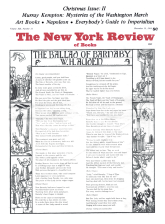In response to:
Enemies of Progress from the October 23, 1969 issue
To the Editors:
In his review of Menninger, The Crime of Punishment, and Goldstein, The Insanity Defense, Professor Packer comments very carelessly and erroneously on the Model Sentencing Act. It is fine that all of section 5 is reproduced in the review. But it is a pity that other sections are not cited; I hope Professor Packer is familiar with them. [NYR, October 23]
As he points out, the Nixon administration proposal on prevention detention applies to “indicted crimes pending trial,” that is, the person who would be preventively detained has not been convicted. But as the reader of section 5 can see, that section applies only to defendants who have been convicted. Not only that, but the long sentence authorized by the section is severely limited to crimes of personal violence, and of these, only where the defendant is suffering from a severe personality disorder indicating a propensity toward criminal activity.
What is not touched on is that the non-dangerous offender, that is, those not within section 5, may not be committed to over five years, including the parole period. Anyone familiar with existing penal codes knows that the application of the Model Sentencing Act would serve to reduce terms of imprisonment.
Professor Packer snidely refers to “the kindly attention of psychiatrists referred to in subsections (a) and (b).” But if he will read the section, the word “psychiatrist” does not appear in it.
Professor Packer refers to “indeterminate commitments” under the Act, as though it were a vicious thing. Nowhere in the Act is there any reference to “indeterminate commitments,” and, in fact, that usage is warned against. What does he mean? If he were to read the rest of the Act, he would discover that it does not permit any minimum term of parole eligibility to be fixed. That is, a person committed can be released at any time. There are very, very few jurisdictions in which that is possible today.
He considers Herbert Wechsler, draftsman of the Model Penal Code of the American Law Institute, a hero for not having been an Isaac Ray Award lecturer; and presumably the Model Penal Code is good. But surely he knows that the “indeterminate sentence” of the Model Penal Code provides for inordinately long sentences, both minimum terms of parole eligibility and maximum terms. I am nearly certain that Professor Packer has read the Model Penal Code, or part of it, and must know that.
Sol Rubin
Counsel
National Council on Crime and Delinquency
New York City
Herbert L Packer replies:
I suppose that it is natural for Mr. Rubin to spring to the defense of his brainchild. His charge that my comments are careless and erroneous I need not characterize. To begin with, he chides me for not referring to other sections of the Act, with which I am indeed familiar. I commented only on Section 5, because it is the one section to which Menninger’s argument is germane. Mr. Rubin is correct in saying that there is no reference to psychiatrists in Section 5. True, but who else is expected to testify about “dangerousness” subsection (c), the “wild card” of Section 5, which covers, inter alia, “selling or knowingly and unlawfully transporting narcotics, or other felony, committed as part of a continuing criminal activity in concert with one or more persons.” I can’t say that I blame Mr. Rubin for being ashamed of that provision. He alleges that “preventive detention” is not implied in Section 5. His point, which is one of word usage, is in error. Although it is true that the term has lately been used to refer to pretrial detention, I assume that Mr. Rubin is not ignorant of the English and Continental usage of the term, as descriptive of a variety of sentencing devices for imposing long terms on persons convicted of crime who are thought to be “dangerous.” Mr. Rubin sticks again, on a point of word usage, at my reference to “indeterminate commitment,” which is used to refer to any sentencing system, even the most enlightened, which does not give the judge the power to impose fixed terms of imprisonment. I will not bore the readers of this Review with a section-by-section comparative analysis of the Model Sentencing Act and the Model Penal Code’s sentencing provisions; it is enough to say that I disagree with much in both Acts.
This Issue
December 18, 1969



